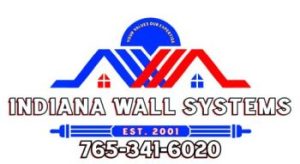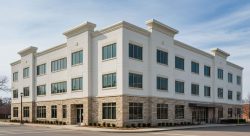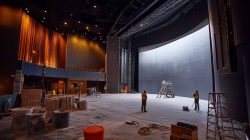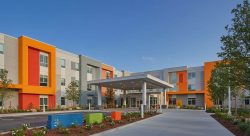Rapid-Cure Coatings Turn Yesterday’s Storefront Into Today’s Fresh-Brand Façade All Before Sunrise.
When major retail chains need a fresh look without closing their doors, rapid EIFS painting and coating systems deliver the impossible. Picture this: customers walk into a completely transformed store the morning after what seemed like a routine Tuesday night. The secret? Advanced night-shift painting crews armed with cutting-edge quick-dry elastomeric coatings that cure faster than traditional systems.
At Indiana Wall Systems, Jeff Johnson has orchestrated dozens of these overnight façade facelifts for national chains across the Midwest. “We’ve perfected the art of the invisible makeover,” Johnson explains. “When done right, customers think the building was always that color.”
This revolutionary approach to commercial EIFS restoration combines advanced acrylic-based coating technology with strategic project management. The result? Zero-downtime exterior rehab that protects revenue while delivering stunning visual transformations.
Key Takeaways
- 24-hour return-to-service is achievable with rapid-curing EIFS coatings
- Zero-downtime storefront makeovers protect revenue during renovations
- Night-shift painting crews complete full rebrands while stores sleep
- Silicone-modified acrylic finishes provide superior durability and weather protection
- Digital moisture scanning ensures coating adhesion and prevents future failures
- National portfolio rebrands can be completed in months, not years
- Energy-efficient cladding upgrades reduce operating costs while improving appearance
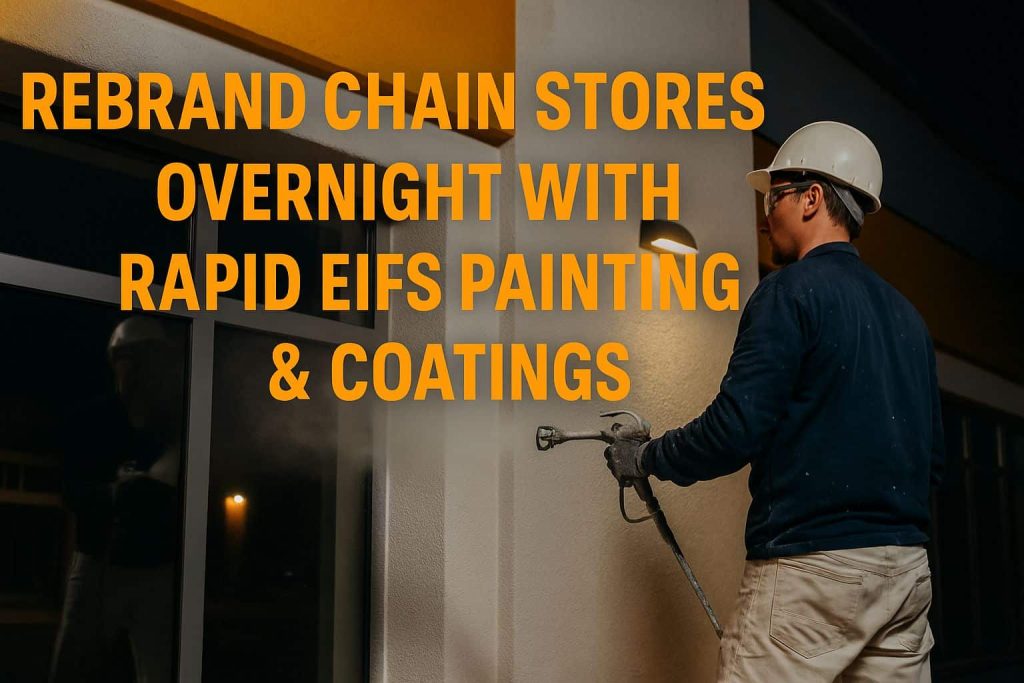
Understanding Modern EIFS Coating Chemistry
The Science Behind Rapid-Cure Technology
Traditional EIFS painting required 48-72 hours of cure time before weather exposure. Today’s rapid-curing acrylic EIFS coatings change that equation completely. These advanced formulations represent a quantum leap in synthetic stucco maintenance technology.
Key chemical innovations include:
- Silicone-modified acrylic polymers that crosslink faster than conventional latex systems
- Hydrophobic EIFS coatings that repel water while allowing vapor transmission
- Breathable waterproof membranes that protect without trapping moisture
- UV-stable pigments that resist fading for decades
- Low-VOC exterior coatings that meet stringent environmental standards
The chemistry revolves around silicone-enhanced polymer chains that form stronger, more flexible bonds than traditional acrylic paint. These coatings create a layer of protection that enhances both appearance and building envelope performance.
Advanced Coating Formulations
Stocolor® Acryl Plus represents the gold standard in rapid-cure EIFS coatings. This system combines exceptional color retention with crack-bridging elastomer properties that accommodate building movement.
Dryvit RapidDry DM 35-50 takes speed to the next level. This rapid-curing acrylic EIFS coating achieves initial cure in just 4-6 hours, even in temperatures as low as 35°F. The system’s low-temperature application window extends the working season dramatically.
Performance characteristics include:
- Superior adhesion to existing EIFS surfaces
- Excellent vapor permeability prevents moisture entrapment
- Outstanding UV resistance maintains color integrity
- Flexible film formation accommodates thermal movement
- Mildew resistance prevents biological growth
- Easy cleaning with soap and water
Temperature-Adaptive Solutions
🌡️ Temperature Performance & Application Windows
Optimal Working Conditions for Rapid EIFS Coating Systems
🌡️ Temperature Application Ranges
📅 Indiana Seasonal Application Opportunities
🌤️ Weather Factor Impact Matrix
Cold-weather application represents a major breakthrough in EIFS coating technology. While standard house paint fails below 50°F, specialized EIFS paints remain workable in challenging conditions.
🏢 EIFS Coating Performance Comparison
Temperature Limits, Cure Times & Warranty Coverage
| 🎨 Coating Type | 🌡️ Min. Application Temp | ⏱️ Cure Time to Rain | 🌡️ Service Temp Range | 🛡️ Typical Warranty |
|---|---|---|---|---|
Standard Acrylic | 50°F | 24 hours | -20°F to 180°F | 5-10 years |
Rapid EIFS Coating | 35°F | 4-6 hours | -30°F to 200°F | 10-15 years |
Premium Elastomeric | 32°F | 2-4 hours | -40°F to 220°F | 15-20 years |
Ultra-Rapid Systems ⭐ | 28°F | 1-3 hours ! | -50°F to 250°F | 20-25 years ✓ |
Note: Performance specifications may vary based on substrate conditions, humidity levels, and specific product formulations. Consult with certified EIFS contractors for project-specific recommendations.
Strategic Planning for Zero-Downtime Commercial Rebrands
⏰ Rapid vs Traditional Project Timeline Comparison
Zero-Downtime Advantage • Hour-by-Hour Breakdown
⚡ The Rapid EIFS Advantage
Pre-Construction Assessment Phase
Every successful storefront reimaging program begins months before the first brush touches the wall. Comprehensive site evaluation ensures project success and prevents costly delays.
Essential assessment components:
- Digital moisture scanning using infrared technology
- Infrared façade inspection to identify thermal anomalies
- Field adhesion test tape pulls at multiple locations
- Substrate compatibility evaluation for coating selection
- Color-matching service for brand compliance
- Traffic control planning for after-hours access
- Occupancy health compliance review
Moisture management becomes critical during assessment. Professional EIFS inspections identify areas where water vapor accumulation could compromise coating adhesion.
Building Envelope Analysis
EIFS buildings require specialized evaluation techniques. Unlike traditional masonry or siding, synthetic stucco systems create unique coating challenges that demand expert assessment.
Key evaluation criteria:
- Substrate moisture content verification
- Existing finish condition assessment
- Sealant joint restoration requirements
- Crack patterns that indicate structural movement
- Previous repair history and coating compatibility
- Thermal bridging locations that affect performance
Johnson’s team uses advanced inspection techniques to evaluate each project thoroughly. “We’ve learned that five minutes of proper assessment saves hours of remedial work later,” he notes.
Color Science and Brand Compliance
Brand identity refresh projects demand precise color matching across hundreds of locations. Modern color-matching services use spectrophotometry to ensure consistency within Delta E values of less than 1.0 – virtually imperceptible to the human eye.
Color selection considerations:
- Fade-resistant color palette options
- Heat island effect impact on dark colors
- Regional climate considerations for color stability
- Maintenance frequency based on color choice
- Energy efficiency implications of color selection
- Local zoning and architectural review requirements
UV-stable pigments prevent the color fade that plagued earlier EIFS paint systems. Premium formulations include colorfast warranties extending 15-20 years for qualified installations.
Advanced Application Techniques for Commercial Success
Night-Shift Crew Operations
After-hours crew deployment requires specialized training and equipment. Night-shift painting crews work under unique challenges that demand modified techniques and enhanced safety protocols.
Operational considerations include:
- After-hours jobsite lighting for quality control
- Noise ordinance adherence in commercial districts
- Security coordination with building management
- Temperature monitoring for optimal cure conditions
- Wind-load resistance considerations for tall buildings
- Traffic control plans for safe equipment access
Professional painting crews use specialized lift equipment scheduling that maximizes productivity while minimizing disruption to adjacent businesses.
Surface Preparation Excellence
Proper surface preparation determines coating longevity and appearance. EIFS surface preparation requires different techniques than traditional stucco or masonry.
Preparation sequence:
- Surface prep pressure washing to remove dirt and biological growth
- Crack repair using compatible elastomeric materials
- Sealant joint restoration with expansion-joint sealant compatibility
- Primer application using alkali-resistant primer systems
- Adhesion promoter application where required
- Base coat repair of damaged areas
Proper EIFS cleaning methods prevent damage to the finish while ensuring optimal coating adhesion. Low pressure washing techniques protect the EIFS finish coat from erosion.
Multi-Layer System Application
Modern EIFS coating systems employ multiple specialized layers, each serving specific performance functions. Understanding layer interactions ensures optimal system performance.
System architecture:
- Penetrating bonding agents improve adhesion to existing finishes
- Alkali-resistant primers prevent substrate bleed-through and ensure uniform color
- High-build acrylic surfacers level surface imperfections and provide texture consistency
- Siloxane water-repellent layers create hydrophobic protection without blocking vapor transmission
- Topcoat application delivers final aesthetic and protective performance
🏗️ Multi-Layer EIFS Coating System Architecture
Advanced Protection Through Strategic Layer Design
5️⃣ Topcoat Application
Final aesthetic and protective barrier
4️⃣ Siloxane Water-Repellent Layer
Hydrophobic protection with vapor permeability
3️⃣ High-Build Acrylic Surfacer
Levels imperfections and provides texture consistency
2️⃣ Alkali-Resistant Primer
Prevents substrate bleed-through and ensures uniform color
1️⃣ Penetrating Bonding Agent
Improves adhesion to existing EIFS surfaces
🧱 Existing EIFS Substrate
Synthetic stucco base system
🎯 System Performance Benefits
🛡️ Protection Performance
⚡ Application Advantages
📏 Total System Specifications
Complete multi-layer protection system
Each layer lasts for years when properly applied and maintained. The multi-layer approach provides redundant protection against water intrusion and weather-related damage over time.
Cutting-Edge Materials and Technologies
Elastomeric Coating Systems
Elastomeric coatings excel at bridging hairline cracks while maintaining vapor permeability. These systems stretch up to 400% without breaking – crucial for EIFS cladding that experiences significant thermal movement.
Performance characteristics:
- Crack-bridging capabilities up to 1/8 inch
- Temperature flexibility from -40°F to 200°F
- Superior elongation properties prevent coating failure
- Excellent adhesion to various EIFS manufacturer products
- Mildew resistance prevents biological growth
- Easy maintenance with standard cleaning methods
Dowsil AllGuard Elastomeric provides superior elongation properties compared to standard acrylic coatings. The result? Fewer callbacks for crack repairs and enhanced long-term durability.
Smart Coating Technologies
The future of EIFS includes revolutionary smart materials that respond to environmental conditions. These innovations represent the next generation of building envelope protection.
Emerging technologies:
- Self-cleaning photocatalytic finishes break down organic pollutants using UV energy
- Anti-graffiti clear coats allow easy vandalism removal without surface damage
- Color-changing formulations respond to temperature for dynamic thermal management
- Self-healing polymers automatically seal minor cracks and surface damage
- Antimicrobial additives prevent mold growth and biological contamination
These advanced systems may revolutionize commercial building maintenance within the next decade.
Water-Managed EIFS Integration
Drainage-plane EIFS systems require specialized coating approaches. Water-managed EIFS assemblies incorporate moisture management features that affect coating selection and application.
System compatibility requirements:
- Vapor-permeable coating films that don’t interfere with drainage
- Sealant compatibility with drainage plane materials
- Thermal expansion accommodation at system transitions
- Freeze-thaw durability in moisture-prone areas
- Wind-driven rain defense at critical junctions
Modern EIFS systems must conform to ASTM E2570 standards for water resistance performance.
Regional Climate Considerations for Indiana Projects
Seasonal Weather Challenges
Indiana’s diverse climate creates unique challenges for EIFS coating applications. Freeze-thaw cycles test coating flexibility while high humidity affects cure times and application windows.
Climate-specific considerations:
- Winter temperature extremes down to -20°F
- Summer heat exceeding 100°F with high humidity
- Rapid temperature fluctuations during spring and fall
- Wind-driven rain from severe storm systems
- Ice formation during winter freeze cycles
- UV exposure intensity during peak summer months
Seasonal application timing becomes critical for project success. Optimal timing for exterior renovations balances weather conditions with business operational needs.
Local Building Code Compliance
Building code compliance varies significantly across Indiana municipalities. Commercial projects must meet specific performance standards while maintaining aesthetic requirements.
Compliance requirements include:
- Fire-resistance ratings for occupied buildings
- Energy efficiency standards for commercial structures
- Accessibility compliance during renovation work
- Environmental regulations for coating emissions
- Historic preservation requirements in designated districts
- Zoning compliance for color and architectural changes
ICC-ES approved systems ensure compliance with local building codes while providing manufacturer warranties. Professional contractors maintain current knowledge of evolving regulations across their service areas.
Energy Efficiency Optimization
Energy-efficient cladding upgrades provide significant operational cost savings. Properly applied EIFS coatings can reduce HVAC costs by 10-15% through improved thermal performance.
Energy benefits include:
- Thermal bridging reduction at structural connections
- Continuous insulation performance enhancement
- Air infiltration reduction through proper sealing
- Solar reflectance optimization with cool color selection
- Thermal mass benefits from system integration
💡 EIFS Energy Efficiency & Savings Calculator
Thermal Performance Benefits • HVAC Cost Reduction Analysis
🏢 Annual Energy Savings by Building Type
Small Commercial
2,000-5,000 sq ft
Medium Commercial
5,000-20,000 sq ft
Large Commercial
20,000-100,000 sq ft
Enterprise Complex
100,000+ sq ft
⚡ Key Energy Performance Factors
Thermal Bridging Reduction
Continuous insulation eliminates heat transfer through structural elements
Air Infiltration Control
Seamless coating application reduces unwanted air leakage by 40-60%
Solar Reflectance
Cool color options reflect 70-85% of solar heat, reducing cooling loads
📈 Energy Savings ROI Timeline
💰 Available Incentives & Rebates
🏛️ Federal & State Programs
⚡ Utility Company Rebates
🎯 Your Energy Savings Potential
Calculate your specific savings with Indiana Wall Systems
Energy efficiency improvements often qualify for utility rebates and tax incentives, further improving project economics.
Specialized Product Systems for Rapid Deployment
Dryvit RapidDry Technology Platform
Dryvit RapidDry DM™ represents a breakthrough in fast-cure EIFS base coat technology. This system dries faster than traditional EIFS adhesives while maintaining superior performance characteristics.
System advantages:
- Two installation steps completed in one workday during cold weather
- Adequate working time for large-scale applications without rushing
- Use with Dryvit systems during colder weather extends the application season
- Substrate tolerance allows application over slightly damp surfaces
- Superior bond strength to expanded polystyrene and other substrates
The system permits installation steps to be completed in colder weather during one workday, revolutionizing winter application possibilities. Insulation board installation and rasping can proceed without weather delays that traditionally halt projects.
StoTherm CI Performance Systems
StoTherm CI GPS provides continuous insulation retrofit capabilities while supporting rapid coating schedules. The system combines thermal performance improvements with aesthetic upgrades in a single project phase.
Technical specifications:
- R-value improvements up to R-20 depending on thickness
- Thermal bridge elimination at structural connections
- Vapor permeability maintains building envelope health
- Fire resistance ratings meet commercial building codes
- Impact resistance from slit mesh reinforcement layers
Sto Elastomeric Coatings offer exceptional crack-bridging elastomer performance. These coatings maintain flexibility at temperature extremes while providing superior color retention and dirt pickup resistance.
Neoflex Advanced Polymer Systems
Neoflex wall coatings utilize GenioSil STP-E polymer technology for enhanced durability and rapid cure characteristics. These systems excel in high-traffic commercial environments where durability and appearance retention are critical.
Performance features:
- Silicone-modified acrylic backbone for superior flexibility
- Self-priming capabilities reduce application steps
- Excellent dirt pickup resistance maintains appearance
- Superior color retention prevents premature fading
- Easy application by spray, roller, or brush methods
The system’s breathable characteristics prevent moisture entrapment while providing excellent weather-tight enclosure performance.
Technical Specifications and Quality Control
Application Standards and Procedures
Professional application requires strict adherence to manufacturer specifications and industry best practices. Quality work depends on consistent techniques and proper material handling.
Application parameters:
🔬 EIFS Application Standards & Quality Control
Professional Testing Protocols & Performance Specifications
| 📊 Parameter | 📋 Specification | 🧪 Test Method | ⏰ Frequency |
|---|---|---|---|
Mil-thickness Build Critical for performance | 8-15 mils DFT Standard | ASTM D7091 Dry Film Thickness | Every 1000 sq ft Systematic Testing |
Adhesion Strength Bond integrity test | >150 PSI Minimum Required | ASTM D4541 Pull-Off Test | Daily Quality Control ! |
Surface Temperature Application window | 35-90°F Optimal Range | IR Thermometer Non-Contact | Continuous Real-Time Monitor |
Relative Humidity Cure conditions | <85% Maximum Level | Digital Meter Precision Gauge | Hourly Regular Check |
Wind Speed Safety & quality limit | <25 mph Maximum Safe | Anemometer Wind Gauge | Continuous Safety Monitor ⚠ |
Drying Time ⏱️ Cure verification | Per Spec Sheet Variable by Product | Touch Test Field Method | As Needed Situational |
Critical Note: All parameters must be within specifications for warranty compliance. Continuous monitoring ensures optimal application conditions and long-term coating performance. Non-compliance voids manufacturer warranties.
Spray-applied acrylic coating techniques ensure uniform coverage while maintaining productivity. Roller/brush touch-up provides detailed work quality that distinguishes professional installations.
Quality Assurance Protocols
Post-installation inspection reports document coating thickness, adhesion test results, and color verification. Digital photography provides before/after documentation for franchise compliance and warranty claims.
Inspection checklist includes:
- Color uniformity across all surfaces
- Coating thickness verification at multiple points
- Edge detail quality and consistency
- Sealant installation completeness and appearance
- Clean-up completion and site restoration
- Warranty documentation and material certificates
Professional results require systematic quality control throughout the application process. Johnson’s team maintains detailed records that satisfy manufacturer requirements and provide legal protection for building owners.
Performance Testing and Validation
Field testing validates coating performance under actual service conditions. Accelerated aging tests predict long-term performance characteristics.
Standard test protocols:
- ASTM G154 – UV exposure and condensation cycling
- ASTM D2247 – 100% humidity exposure testing
- ASTM D522 – Mandrel bend flexibility testing
- ASTM D713 – Salt spray corrosion resistance
- ASTM E96 – Water vapor transmission rates
- ASTM C836 – Accelerated weathering procedures
These tests ensure coating durability under Indiana’s challenging climate conditions.
Cost Analysis and Project Economics
Direct Cost Comparisons
Rapid EIFS coating systems typically cost 15-25% more than standard materials. However, the zero-downtime advantage more than offsets the material premium for most commercial applications.
💰 EIFS Rapid Coating Cost Analysis & ROI Calculator
Zero-Downtime vs Traditional Approach • Revenue Protection Analysis
| 🏢 Project Scope | 💸 Traditional Cost | 🧱 Material Cost | 👷 Labor Cost | 🚀 Total Rapid System | 🛡️ Revenue Protected | 📈 Net Benefit |
|---|---|---|---|---|---|---|
Single Store Restaurant, Retail Shop | $12,000 2-3 Day Closure | $15,000 Premium Coatings | $8,000 Night Crew | $23,000 Total Investment ✓ | $25,000/day Daily Revenue | $2,000+ First Day Profit 💚 |
Strip Mall (5 units) Multi-tenant Complex | $55,000 Staggered Closure | $68,000 Bulk Purchase | $35,000 Coordinated Crews | $103,000 Total Investment | $100,000/day Combined Revenue | Break-even Day 2+ Profit ⚖️ |
Big Box Retail Department Store, Supermarket | $38,000 Weekend Closure | $48,000 High-Performance | $28,000 Large Crew | $76,000 Total Investment | $150,000/day High Volume Sales 🛒 | $74,000+ Immediate ROI 🚀 |
Shopping Center ⭐ Major Commercial Complex | $95,000 Phased Closure | $118,000 Enterprise Grade | $72,000 Multiple Crews | $190,000 Total Investment 🏆 | $300,000/day Multi-Tenant Revenue 🔥 | $110,000+ Massive ROI 💎 |
💡 Key Success Factors
- Zero downtime protects daily revenue streams
- Night-shift crews eliminate customer disruption
- Rapid-cure coatings enable same-day completion
- Professional execution ensures warranty compliance
📊 Financial Benefits
- Immediate ROI – payback within 1-2 days
- Revenue protection – no lost sales during work
- Enhanced property values from premium appearance
- Lower insurance costs from improved weather protection
💰 ROI Timeline Breakdown
Day 1: Project completion, immediate revenue protection
Day 2-30: Enhanced curb appeal drives increased foot traffic
Month 2+: Reduced maintenance costs and energy savings
Investment Note: Costs include premium rapid-cure materials, specialized night-shift labor, and comprehensive warranty coverage. Traditional closure costs exclude lost revenue, customer attrition, and potential security issues. Revenue protection calculations based on average daily sales data.
Lifecycle Cost Benefits
Extended coating lifespan from premium materials reduces maintenance frequency. 15-20 year warranties provide predictable maintenance budgets for property managers.
Long-term economic advantages:
- Reduced maintenance frequency cuts lifecycle costs
- Energy savings from improved thermal performance
- Enhanced property values from superior appearance
- Lower insurance premiums from weather protection
- Reduced vacancy rates from maintained curb appeal
- Increased rental rates for well-maintained properties
Return on investment typically occurs within 2-3 years for most commercial applications.
Financing and Budget Planning
Facility manager checklists help organizations plan coating projects efficiently. Life-cycle maintenance plans spread costs over appropriate timeframes.
Budget considerations include:
- Material costs vary by the coating system selected
- Labor costs affected by application timing and complexity
- Equipment rental for specialized application needs
- Permitting fees where required by local jurisdictions
- Insurance requirements for contractor and project coverage
- Contingency planning for weather-related delays
Property management budgeting benefits from predictable coating schedules based on manufacturer recommendations.
Advanced Project Management Strategies
Logistics and Coordination
National roll-out logistics require sophisticated project management capabilities. Coordinating multiple crews across different time zones while maintaining quality standards demands proven systems.
Management components:
- Crew scheduling optimization for maximum efficiency
- Material procurement and inventory management
- Quality control standardization across all locations
- Weather monitoring and contingency planning
- Communication protocols with franchise operations
- Progress reporting for stakeholder updates
Project progress punch lists track completion status and identify potential issues before they impact schedules.
Safety and Compliance Management
Contractor safety protocols protect workers while maintaining productivity. OSHA compliance requirements vary by project size and location characteristics.
Safety program elements:
- Fall protection systems for elevated work
- Respiratory protection for coating application
- Chemical handling procedures for material safety
- Traffic control coordination with local authorities
- Emergency response planning for job site incidents
- Training documentation for all crew members
Johnson emphasizes that “Safety comes first on every project. A safe crew is a productive crew.”
Communication and Stakeholder Management
Clear communication prevents misunderstandings that can derail commercial projects. Facility managers need regular updates on progress and any issues that arise.
Communication protocols include:
- Daily progress reports with photo documentation
- Weather impact assessments and revised schedules
- Quality checkpoints with client sign-offs
- Issue escalation procedures for prompt resolution
- Final inspection coordination and warranty documentation
Future Innovations and Technology Trends
Emerging Coating Technologies
Next-generation EIFS coatings promise even greater performance and application flexibility. Research and development continues advancing the state of the art.
Innovation areas include:
- Nano-technology integration for enhanced properties
- Smart responsive materials that adapt to conditions
- Self-diagnosing coatings that indicate maintenance needs
- Rapid application systems reducing labor requirements
- Environmentally sustainable formulations with bio-based content
Automation and Robotics Integration
Robotic application systems may revolutionize large-scale coating projects. Consistent application thickness and reduced labor costs could make premium systems more accessible.
Potential applications:
- Automated surface preparation using robotic systems
- Precise coating application with computerized controls
- Quality inspection using machine vision systems
- Progress monitoring through integrated sensors
- Material handling automation for improved efficiency
Drone-based inspection technology already assists with infrared façade inspections and progress monitoring. Integration with coating application represents the next logical step.
Sustainability and Environmental Advances
Environmental sustainability drives innovation in coating chemistry and application methods. Zero-VOC systems address increasingly strict air quality regulations.
Sustainable developments:
- Bio-based raw materials replacing petroleum-derived components
- Recyclable systems designed for easy removal and reprocessing
- Carbon footprint reduction through improved application efficiency
- Renewable energy integration for coating production
- Circular economy principles in material design
These innovations align commercial building maintenance with environmental stewardship goals.
Frequently Asked Questions
How quickly can EIFS coatings be recoated for a complete color change?
Rapid-curing EIFS coatings typically allow recoating within 4-6 hours under ideal conditions. Temperature and humidity significantly impact cure times, with cold or humid conditions extending the process. For a drastic color change, additional primer coats may be required, extending the timeline to 8-12 hours total.
What temperature limits exist for night application of rapid systems?
Most rapid EIFS systems remain workable down to 35°F with proper additives. Specialized cold-weather formulations can extend this to 32°F, though cure times increase significantly at lower temperatures. Heated spray equipment and temperature monitoring ensure consistent application quality during challenging conditions.
How long do rapid coating systems last compared to traditional applications?
Premium rapid-cure coatings offer the same 15-20 year lifespan as traditional systems when properly applied. UV-stable pigments and elastomeric formulations ensure long-term color and flexibility retention. The key difference lies in application speed, not performance longevity.
Can existing EIFS be coated without primer for rapid turnaround?
Substrate compatibility testing determines primer requirements for each project. Most existing EIFS surfaces benefit from alkali-resistant primers that improve adhesion and color uniformity. Self-priming systems eliminate separate primer application while maintaining performance standards, reducing overall project time.
What warranty coverage applies to rapid systems versus traditional coatings?
Manufacturer warranties for rapid systems match those of traditional coatings when installed per specifications. Material warranties typically extend 15-20 years, while contractor workmanship warranties cover 2-5 years beyond material coverage. Warranty compliance requires documented application procedures and quality control records.
How does weather affect rapid coating performance and cure times?
Wind, humidity, and temperature all impact coating performance significantly. Digital weather monitoring helps crews optimize application timing for best results and fastest cure times. Low humidity accelerates curing, while high humidity can extend cure times by 50-100%. Wind speeds above 25 mph should halt application to prevent overspray and quality issues.
What makes EIFS coatings different from regular exterior paint?
EIFS coatings are specifically formulated for synthetic stucco systems with enhanced flexibility and vapor permeability. Regular house paint lacks the elastomeric properties needed to bridge small cracks and accommodate thermal movement. EIFS-specific formulations also provide better adhesion to acrylic-based substrates common in exterior insulation and finish systems.
How do you prevent moisture problems when painting EIFS overnight?
Moisture management during overnight application requires careful attention to drying time and relative humidity levels. Vapor-permeable coatings allow trapped water vapor to escape while blocking liquid water infiltration. Digital moisture scanning before application identifies problem areas that need repair before coating. Proper ventilation and temperature control optimize cure conditions.
Transform your commercial property with zero downtime. Contact Jeff Johnson and the expert team at Indiana Wall Systems at (765) 341-6020 for a comprehensive consultation on rapid EIFS coating solutions. Our proven overnight transformation approach protects your revenue while delivering stunning visual results that drive customer traffic and enhance property values.
With over 22 years of specialized experience and 160 years of combined expertise, Indiana Wall Systems delivers commercial EIFS solutions that work as hard as your business. Experience the difference that professional quality and innovative technology make for your next commercial renovation project.
